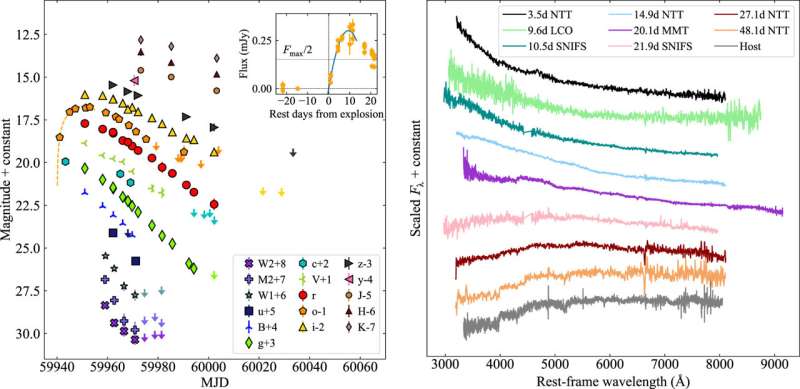September 7, 2023 report
This article has been reviewed according to Science X's editorial process and policies. Editors have highlighted the following attributes while ensuring the content's credibility:
fact-checked
peer-reviewed publication
trusted source
proofread
New class of super-bright exploding transient discovered

A large international team of astronomers and astrophysicists has discovered something new in the night sky—a type of explosion that is much brighter than most supernovae and is called luminous fast cooler (LFC). In their paper published in The Astrophysical Journal Letters, the group describes the explosion, how it was found and what they have learned about it thus far.
Previously, supernovae were believed to produce the brightest type of explosion in the known universe. They occur when stars run out of fuel and collapse in on themselves—and then explode in a mighty burst of light and energy. Many such events have been recorded. But now, it appears that another phenomenon may challenge supernovae as the brightest type of explosion.
An explosion was detected as team members were analyzing data captured by the ATLAS network of robotic telescopes. As the progression of the explosion unfolded, the researchers came to realize that what they were witnessing was not a supernova. In addition to its incredible brightness, it was located in a place where supernova do not occur—a galaxy with billions of stars near in size to the sun. Thus, it was not likely such a galaxy would have a star big enough to become a supernova.
The research team found that the explosion progressed much more quickly than any known supernova. Instead of taking 20 days to reach peak brightness and then ebbing over the following months, the event they were witnessing took just 15 days to reach its peak brightness and then ebbed away to nothing after just one month.
Surprised by their observations, the researchers began sifting through archival telescope data and found two other instances of similar explosions—one that occurred in 2020 and another in 2009. They suggest that such events are a previously unknown type of explosion of unknown cause. And because the find is still so new, there is not yet any evidence to explain why they occur.
The research team suggests it is possible that they are the result of a black hole and a star colliding. Much more work is required to find out if that is the case, or if the explosions are due to something else entirely.
More information: M. Nicholl et al, AT 2022aedm and a New Class of Luminous, Fast-cooling Transients in Elliptical Galaxies, The Astrophysical Journal Letters (2023). DOI: 10.3847/2041-8213/acf0ba
Journal information: Astrophysical Journal Letters
© 2023 Science X Network





















